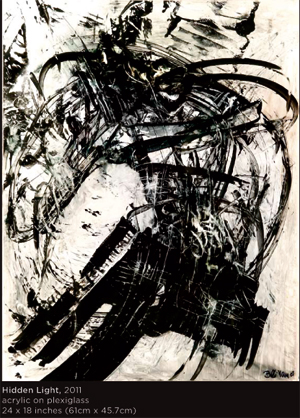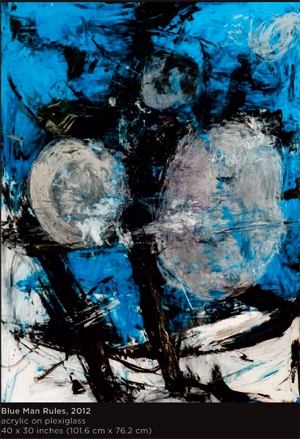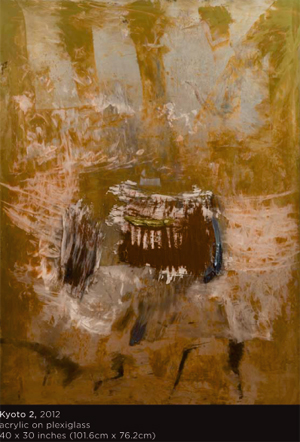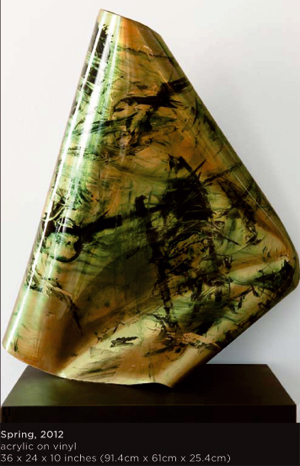|
zur Startseite
|
Malerei | USA |

|
|
Giving Voice to Inner Life: The Art of Bobbi Van “Slumbering in every human being lies an infinity of possibilities, which one must not arouse in vain. For it is terrible when the whole man resonates with echoes after echoes, not becoming a real voice.” -- Notes from Hampstead: The Writer's Notes: 1954-1971 |
|
Elias Canetti – novelist, essayist, Nobel laureate -- also cried out in these notes: “Learn to
speak again at fifty-five, not a new language but speech itself.” Bobbi Van found a new
voice and learned to speak again in her fifties, using painting as her mode of expression. |
|
Born in Boston, Massachusetts, Van has lived in New York City since 1970. A business executive at first, she became a painter in the wake of an emotional crisis brought on by the death of her mother. Her response was to train for three years in the Art Students League of New York, a prestigious, forward-looking institution that was founded in 1875 and incubated abstract expressionism, that great American contribution to art’s evolution. A child of the abstract expressionists, Van has built on their achievements, reverse painting on Plexiglas and, more recently, using soft vinyl to create a hybrid form of painting and sculpture that she calls soft sculpture. Translation: Geboren in Boston, Massachusetts, Van lebt seit 1970 in New York City.. Zuerst als Geschäftsführung, wurde sie Malerin durch einen Wink in einer emotionalen Krise, den Tot ihrer Mutter. Drei Jahre Schulung in der Art Students League in New York, ein prestigeträtiges, fortschrittliches Institut das 1875 gegründet wurde, zur Verbreitung der Entwicklung des amerikanischen abstrakten Expressionismus. Als Kind des abstrakten Expressionismus, Van hat eine Technik entwickelt, die reverse painting on Plexiglas ( Rückseitenbemalung von Plexiglas), im Gebrauch von weichem Vinyl, um einen Stil von Malerei und Skulpturen zu kreieren den sie "Soft Sculpture" nennt. |
| Abstract expressionism, art critic April Kingsley said, enabled content “to emerge simply and directly from the artist’s own internal reality.” In so doing, it liberated art from tradition in every respect – a process set in train much earlier of course by Pablo Picasso and the other early 20th century modernists. The important thing for post-war American painters was the expressiveness that modernism enabled. They took it forward in seachanging ways and gave Van a compass that is still opening new worlds. Van’s art makes you think of the output of another American artist – or poet rather – Sylvia Plath, who transformed intense emotion into poetry that another Nobel laureate, Seamus Heaney, characterized with the words, “irresistible given-ness.” Van’s paintings, like Path’s poems, strike you with their “astonished being”, and the imprint of the force they pass through as they come into existence. |
|
As happened with Plath’s mature poetry, which was written very fast, Van paints with
fluency and rapidity. Her first image – the hieroglyph of a thought or feeling emerging in
her – is seminally important. She turns around the Plexiglas base on which she has made
the imprint, she looks at the image, turns the base around again, and develops the image
or improvises around it, acting freely and spontaneously – her painting hand the limb of a
dancer. This vital process of becoming is itself a guarantee of the being that emerges, the
reason why it reveals to the viewer an impregnable legitimacy, a raison d’etre that cannot
be contested. In giving voice to her feelings and ideas, Van creates paintings that signify
their presence through sheer expressiveness. Images and colors and textures have infinite
possibilities -- just as humans do, as Elias Canetti said -- and Van explores their frontiers
even as she surrenders to them, the end product being things of great resonance and
beauty. |
|
Weitere Infos auf der persönlichen Homepage, Further information follow link to homepage Bobbi Van -
www.bobbivanstudio.com
Von 1965 - 2013    
|